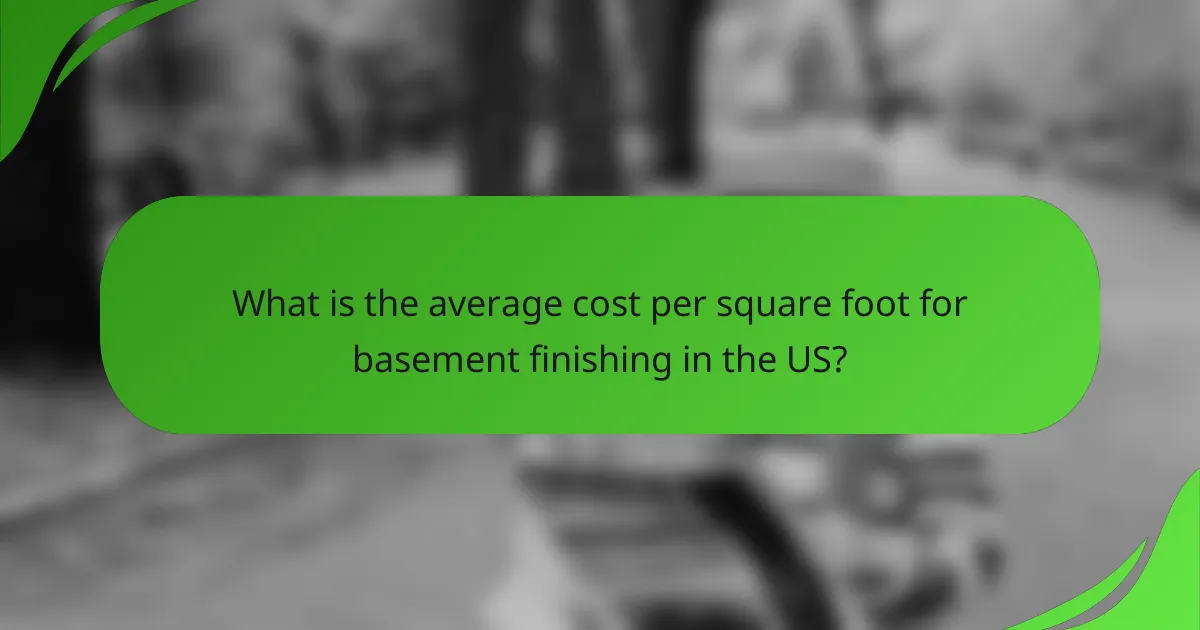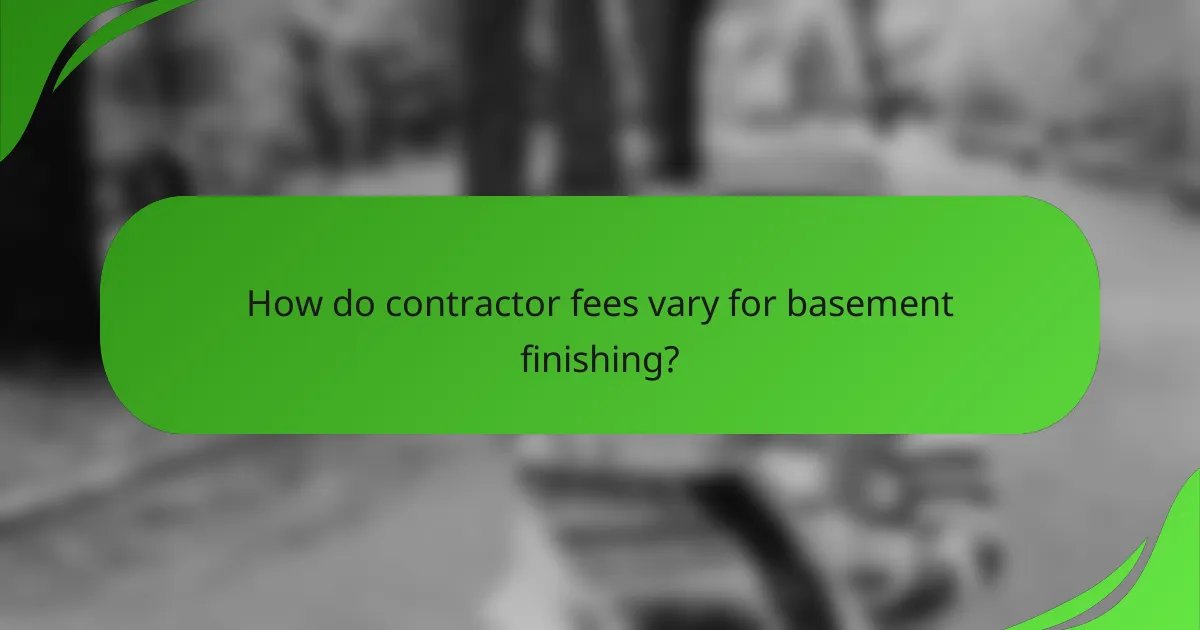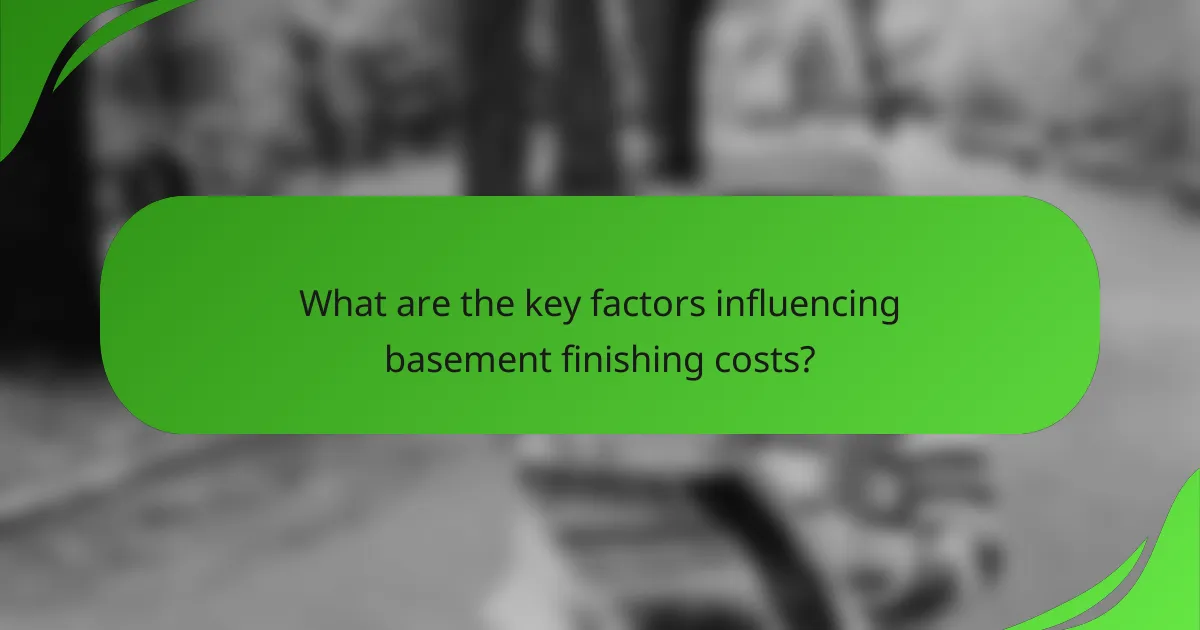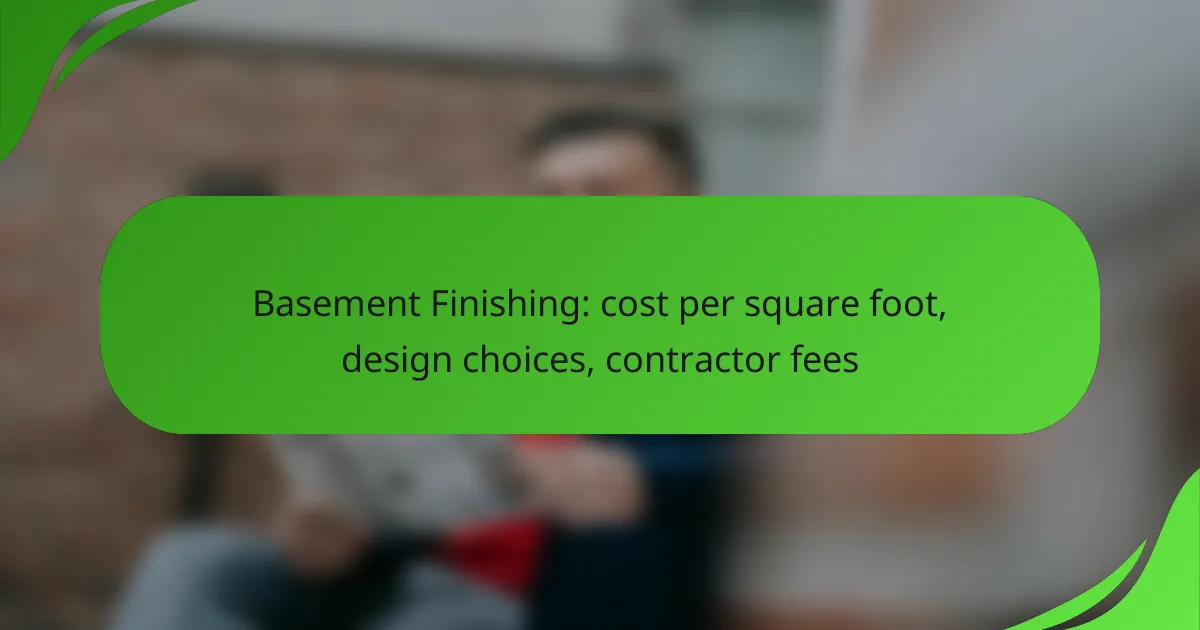Finishing a basement can significantly enhance your home’s value and livability, with costs typically ranging from $30 to $100 per square foot. Factors such as design choices, materials, and contractor fees play a crucial role in determining the final price. Popular designs often prioritize functionality and aesthetics, creating versatile spaces for entertainment and relaxation. Understanding contractor fees and budgeting accordingly is essential for a successful basement renovation project.

What is the average cost per square foot for basement finishing in the US?
The average cost for basement finishing in the US typically ranges from $30 to $100 per square foot. This price varies based on several factors including design choices, materials used, and labor costs.
Cost range of $30 to $100 per square foot
The cost per square foot for finishing a basement can vary widely, generally falling between $30 and $100. For a standard 1,000 square foot basement, this translates to a total cost ranging from approximately $30,000 to $100,000.
Homeowners should consider their budget and desired features when estimating costs. Basic finishes will be on the lower end of the spectrum, while high-end materials and complex designs will push costs toward the upper range.
Factors affecting cost include materials and labor
Several key factors influence the overall cost of basement finishing, primarily the choice of materials and labor rates. High-quality flooring, cabinetry, and fixtures can significantly increase expenses, while more affordable options can help keep costs down.
Labor costs can also vary based on location and contractor experience. It’s advisable to obtain multiple quotes from contractors to ensure competitive pricing and to understand the scope of work included in each estimate.

What design choices are popular for finished basements?
Popular design choices for finished basements often focus on maximizing space and functionality while enhancing aesthetics. Homeowners typically favor layouts that promote openness and areas for entertainment, ensuring the basement serves as a versatile living space.
Open concept layouts
Open concept layouts are favored in finished basements as they create a spacious feel by eliminating unnecessary walls. This design encourages a seamless flow between different areas, such as living, dining, and recreational spaces, making it ideal for gatherings.
When considering an open layout, think about how to define spaces without physical barriers. Use furniture arrangements, area rugs, or lighting to differentiate zones while maintaining an airy atmosphere. This approach can also help in maximizing natural light, which is crucial in basements.
Incorporating wet bars and entertainment areas
Adding wet bars and entertainment areas is a popular choice for finished basements, transforming them into ideal spots for relaxation and socializing. A wet bar can include a sink, refrigerator, and counter space, making it convenient for serving drinks and snacks during gatherings.
When designing these areas, consider the layout and materials that complement the overall basement design. Durable surfaces that are easy to clean, such as quartz or granite, work well. Additionally, ensure there is adequate seating and entertainment options, like a large screen or gaming area, to enhance the experience for guests.

How do contractor fees vary for basement finishing?
Contractor fees for basement finishing typically depend on the total project cost and the fee structure chosen. Understanding these fees can help homeowners budget effectively and select the right contractor for their needs.
Typical contractor fees range from 10% to 20% of project cost
Contractor fees for basement finishing usually fall between 10% and 20% of the overall project cost. For example, if the total cost of finishing a basement is estimated at $20,000, the contractor’s fee could range from $2,000 to $4,000. This percentage can vary based on the complexity of the project, the contractor’s experience, and regional market conditions.
It’s essential to clarify these fees upfront to avoid surprises later. Some contractors may charge a flat fee, while others might base their fees on the percentage of the total project cost, which can lead to significant differences in the final amount paid.
Fee structures: fixed price vs. hourly rates
Contractors may offer different fee structures, with the two most common being fixed price and hourly rates. A fixed price means the contractor provides a total cost for the project upfront, which can be beneficial for budgeting. However, this may not cover unexpected issues that arise during the project.
On the other hand, hourly rates can provide flexibility but may lead to higher costs if the project takes longer than anticipated. Homeowners should assess the pros and cons of each structure and consider factors like project scope and potential complications before making a decision.

What are the key factors influencing basement finishing costs?
The cost of finishing a basement is influenced by several key factors, including the quality of materials, local labor rates, and the overall design choices. Understanding these elements can help homeowners budget effectively and make informed decisions during the renovation process.
Quality of materials used
The quality of materials significantly affects the overall cost of basement finishing. Higher-end materials, such as premium flooring, custom cabinetry, and durable insulation, can increase expenses but also enhance the longevity and aesthetic appeal of the space. For instance, opting for hardwood flooring instead of laminate can raise costs by a notable percentage.
When selecting materials, consider balancing quality with budget. Mid-range options often provide a good compromise, offering durability and style without the premium price tag. Always compare different suppliers to find the best value for your chosen materials.
Geographic location and local labor rates
Your geographic location plays a crucial role in determining labor rates for basement finishing. Urban areas typically have higher labor costs due to increased demand and living expenses, while rural locations may offer more competitive pricing. For example, labor rates in cities like New York or San Francisco can be significantly higher than in smaller towns.
To manage costs effectively, research local contractors and obtain multiple quotes. This will give you a clearer picture of the average labor rates in your area. Additionally, consider the seasonality of construction work; hiring during off-peak times may yield better rates and availability.

What are the prerequisites for hiring a contractor for basement finishing?
Before hiring a contractor for basement finishing, ensure they meet essential qualifications, including proper licensing and insurance. This helps protect you from potential liabilities and ensures the work complies with local building codes.
Verify contractor licenses and insurance
Confirm that the contractor holds the necessary licenses required by your state or local jurisdiction. This may include a general contractor’s license and specific permits for basement work.
Additionally, check that the contractor has liability insurance and workers’ compensation coverage. This protects you from financial responsibility in case of accidents or damages during the project.
Check references and past project portfolios
Request references from previous clients and take the time to contact them. Ask about their experiences, the quality of work, and whether the project was completed on time and within budget.
Review the contractor’s portfolio of past basement finishing projects. Look for examples that match your desired style and quality, ensuring they have experience with similar renovations.

What are the emerging trends in basement finishing?
Emerging trends in basement finishing focus on enhancing functionality and sustainability. Homeowners are increasingly integrating smart technology and eco-friendly materials into their designs, creating spaces that are both modern and environmentally conscious.
Smart home technology integration
Smart home technology is becoming a staple in basement finishing projects. Homeowners are incorporating features such as automated lighting, climate control, and security systems to enhance convenience and energy efficiency. For example, smart thermostats can help regulate temperature, while motion-sensor lights can save energy when the space is not in use.
When considering smart technology, assess compatibility with existing systems and choose devices that offer user-friendly interfaces. Budgeting for these upgrades can vary widely, but allocating a few hundred to a few thousand dollars can provide significant long-term benefits.
Eco-friendly materials and designs
Eco-friendly materials are gaining traction in basement finishing, with options like reclaimed wood, low-VOC paints, and sustainable flooring becoming popular choices. These materials not only reduce environmental impact but also improve indoor air quality, making the space healthier for occupants.
To implement eco-friendly designs, consider using natural light through larger windows or skylights and incorporating energy-efficient insulation. While the initial investment may be higher, the long-term savings on energy bills and the positive environmental impact can make it worthwhile. Aim to allocate around 10-20% of your total budget for sustainable materials to achieve a balance between aesthetics and eco-consciousness.









